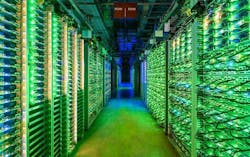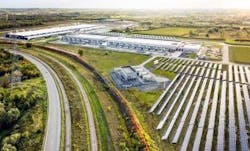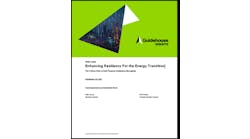Google will use large batteries to replace the diesel generators at one of its data centers in Belgium, describing the project as a first step towards using cleaner technologies to provide backup power for its millions of servers around the world.
“Our project in Belgium is a first step that we hope will lay the groundwork for a big vision: a world in which backup systems at data centers go from climate change problems to critical components in carbon-free energy systems,” said Joe Kava, Vice President for Data Centers at Google. “We’re aiming to demonstrate that a better, cleaner solution has advanced far enough to keep the internet up and running.”
Google becomes the second major hyperscale cloud operator to pursue a strategy to move beyond diesel generators. In July, Microsoft said it will eliminate its reliance on diesel fuel by the year 2030 and has begun testing hydrogen fuel cells as an alternative. These announcements have implications beyond company-built facilities, as Google and Microsoft are major tenants in third-party data centers, most of which use diesel generators for backup power.
Kava says broader use of batteries can accelerate the shift away from fossil fuel, enabling data centers and electric utilities to overcome the intermittent nature of renewable sources like wind and solar power. That’s a particular problem for data centers, which must provide uninterrupted power around the clock, in all weather conditions.
“Wind and solar power are currently booming around the world, but sunny days and breezy hours don’t always align with a community’s energy demand,” Kava said in a blog post. “Large-scale batteries at data centers can address this problem by banking renewable power when it’s abundant, and discharging it when it’s needed.”
Google’s research with battery technologies is part of a larger push to collaborate with utilities to create a more sustainable power grid. “Batteries can help balance other kinds of variability on power grids, allowing for more cost-effective and efficient operations,” said Kava. “Working in partnership with ELIA, the local transmission system operator in Belgium, we’ll strive to make our project a model for how data centers can become anchors for carbon-free electric grids.”
Lithium-Ion, Deployed at Scale
The pilot project at Google’s Belgium data center will begin in the summer of 2021, and will use large lithium-ion batteries to replace generators, according to Maud Texier, Carbon Free Energy Lead at Google.
“Once the batteries come online, they will first be tested operating in tandem with generators to validate the performance,” said Texier. “We perceive it as the first-of-a-kind opportunity. We are replacing the diesel generators with batteries on a one-to-one basis, demonstrating the maturity of the batteries.” Texier said Google is currently working with a single vendor, which is not being disclosed.
Google isn’t alone in pursuing broader use of large-capacity batteries. Switch recently unveiled plans to use new large-scale energy storage technology from Tesla to boost its use of solar energy for its massive data center campuses in Las Vegas and Reno.
The price of lithium-ion batteries has fallen by about 80 percent over the past five years, according to the U.S. National Renewable Energy Lab (NREL), enabling the integration of storage into solar power systems. In the third quarter of 2019, the United States saw a 93% increase in the amount of storage deployed, compared to the previous year.
Addressing Technical Challenges
To work in data centers, utility-scale batteries must address two challenges – meeting the capacity requirements, and providing the duration to write out a lengthy outage.
“We see capacity as a low risk,” said Texier, who worked in the battery program at Tesla prior to joining Google in 2019. “We expect batteries to have a very similar modularity as generators. It’s been well demonstrated at similar scale.”
The largest single-site lithium-ion battery installation is the 150-megawatt Hornsdale Power station in Australia, with a handful of other projects in development that will surpass 100 megawatts of battery capacity.
Addressing duration is a more complex challenge. “It’s not just finding the right technologies, but how we look at our load and optimizing our compute during these events,” said Texier.
The goal is “load flexibility” for prolonged outages, which could mean shifting compute workloads to other Google data centers, but also might mean tapping other energy sources.
“Batteries are one piece of the puzzle,” said Texier. “We would expect to look at other technologies as well.”
Building a Greener, More Stable Grid
As some of the world’s largest energy users, cloud computing platforms possess the scale and buying power to reshape the supply chain for computing. Data centers have become important players in power markets, with growing clout but also increased exposure to the complexities of pricing and capacity. Google has gained approval from the Federal Regulatory Energy Commission (FERC) to buy and sell electricity in energy markets, which creates opportunities for collaboration – especially with backup power.
An on-site solar energy array at the Google data center campus iin Belgium. (Photo: Google)
“Whereas diesel generators sit idle most of the year, batteries are multi-talented team players: when we’re not using them, they’ll be available as an asset that strengthens the broader electric grid,” said Kava.
Texier said Google will be looking at new market models for working with utilities on the grids where the company operates data centers. “Grid services are not new to Google,” said Texier. “The challenge is how we pave a path to show the way for others in the industry to follow.”
Google hopes the Belgium pilot project can lay the groundwork for a larger transition in data center backup power, with battery-powered campuses supporting sustainable grids. Kava says the data center industry could drive meaningful change on climate.
“Worldwide, we estimate there are over 20 gigawatts of backup diesel generators in service across the data center industry, representing a massive opportunity to deploy cleaner solutions.,” said Kava.
The efforts by Google and Microsoft to develop alternatives to diesel generators illustrates the potential for hyperscale operators to drive change within the supply chain for data center services.
Matching Every Hour with Clean Energy
Google is a huge consumer of energy, especially in its data center operations. In 2019 the company consumed 12 terawatt hours of energy, more than doubling its total from 2016. But the company is also the largest corporate purchaser of renewable energy, offsetting 100 percent of its power usage.
In September, Google CEO Sundar Pichai outlined Google’s intentions to invest more in energy storage as part of a move to power its entire global information empire entirely with carbon-free energy by 2030, matching every hour of its data center operations to carbon-free energy sources. The Google data center team has been working since 2018 to use artificial intelligence and sophisticated energy provisioning to match its operations to carbon-free energy sources.
“We’ve been working for years to push Google toward a zero-carbon future – from our achievement of carbon neutrality since 2007, to reaching 100 percent renewable energy every year since 2017, and now pursuing our most ambitious goal yet, 24/7 carbon-free electricity by 2030,” said Kava.







